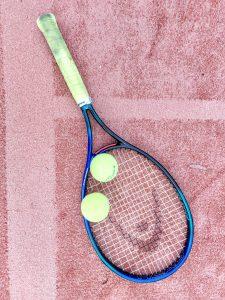We may earn money or products from the companies mentioned in this post.
Introduction

Are you familiar with the sport of pickleball? If not, you’re in for a treat Pickleball is a unique and fast-growing paddle sport that combines elements of tennis, badminton, and ping pong It’s played on a court with similar dimensions to a doubles badminton court, and participants use solid paddles to hit a perforated polymer ball over the net
In recent years, pickleball has gained tremendous popularity across the United States and beyond What started as a backyard game has now evolved into a competitive sport with its own dedicated tournaments and leagues Its appeal lies in its accessibility to players of all ages and skill levels, making it an ideal choice for recreational play or serious competition
Reasons to Convert a Tennis Court into a Pickleball Court

1 Space-Saving Benefits
One of the main reasons why many facilities are converting their tennis courts into pickleball courts is the space-saving benefits A standard tennis court requires significantly more space compared to a pickleball court By converting underutilized or unused tennis courts into multiple pickleball courts, facility owners can make better use of their available space without compromising on gameplay quality
2 Increased Demand for Pickleball Facilities
The demand for pickleball facilities has skyrocketed in recent years due to the growing popularity of the sport More and more people are discovering the joy of playing pickleball and seeking out dedicated courts where they can hone their skills or enjoy friendly matches with friends and family
As such, repurposing underused tennis courts into pickleball courts allows facility owners to cater to this increasing demand effectively This not only attracts new players but also encourages existing players to visit these facilities more frequently, thereby boosting overall engagement and participation levels
3 Opportunity for Increased Revenue
Converting tennis courts into pickleball courts presents a significant opportunity for facility owners to generate increased revenue By offering pickleball as an additional sport, facilities can attract a wider range of customers who may not be interested in or have access to tennis
Pickleball’s appeal extends beyond just traditional tennis players It attracts people from various age groups, including seniors and younger generations who are looking for a fun and engaging physical activity By tapping into this market and creating a welcoming atmosphere for pickleball enthusiasts, facility owners can enhance their revenue streams through court rentals, lessons, leagues, and tournaments
Conclusion

In conclusion, converting tennis courts into pickleball courts offers numerous benefits From maximizing space utilization to meeting the growing demand for pickleball facilities and increasing revenue opportunities, this conversion is a smart move for many sports facilities As the popularity of pickleball continues to soar, now is the perfect time to embrace this exciting sport and provide an exceptional experience for both new and seasoned players alike
Assessing your current tennis court

When considering converting your existing tennis court for a different sport like pickleball, it’s crucial to assess its suitability for the transformation This involves evaluating two key factors: court size requirements and surface considerations
Determining if the existing court is suitable for conversion
The first step in assessing your tennis court is to ensure that it meets the necessary size requirements for a pickleball court While both sports share similarities, there are some differences in dimensions A standard tennis court measures 78 feet in length and 36 feet in width, whereas a pickleball court is smaller at 44 feet in length and 20 feet in width By comparing these measurements, you can determine if your current tennis court can accommodate a pickleball conversion without major modifications
In addition to size comparisons, it’s important to consider the surface of your existing tennis court Tennis courts can be made of various materials such as asphalt, concrete, or clay Each surface type has its own characteristics that may affect gameplay and maintenance requirements for pickleball For instance, an asphalt or concrete surface provides durability but may require resurfacing to meet the specific needs of pickleball players who prefer a slightly softer playing surface
Evaluating the condition of the tennis court
Before proceeding with any conversion plans, it’s crucial to thoroughly evaluate the condition of your tennis court Look out for signs of damage such as cracks, uneven surfaces, or drainage issues that could impact gameplay safety or hinder a successful transition to pickleball
If you notice any cracks on the court’s surface or foundation, they should be addressed promptly to prevent further deterioration and potential hazards during play Uneven surfaces can also pose risks and affect ball bounce consistency Additionally, consider whether proper drainage systems are in place to prevent water accumulation on the court, as this can lead to slippery conditions and affect gameplay quality
By carefully assessing the condition of your tennis court, you can identify any necessary repairs or modifications that need to be made before converting it for pickleball Addressing these issues beforehand will ensure a smooth transition and provide an optimal playing experience for both casual players and enthusiasts alike
Planning the Conversion Process

When embarking on the journey of converting a tennis court into pickleball courts, there are several important considerations to keep in mind One of the first decisions to make is how many pickleball courts you want to create within the existing space This can range from a single-court conversion to a multi-court setup, depending on your needs and available resources
Factors such as net posts and fencing can significantly impact the efficiency of space utilization Careful planning is required to ensure that these elements are properly positioned without compromising the playing area A well-designed layout can maximize court availability while maintaining safety and functionality
Laying Out the New Court Lines and Dimensions
The next step in the conversion process involves laying out the new court lines and dimensions You have two options for marking these lines: temporary or permanent markings Temporary markings using tape or chalk may be suitable for initial conversions, allowing flexibility for adjustments if needed On the other hand, permanent markings offer long-term durability but require careful measurements and precision during installation
Accurate measurements are crucial when aligning with existing features such as fences or walls Ensuring proper alignment not only enhances aesthetics but also improves gameplay by avoiding any irregularities that may affect ball trajectory or player movement
Equipment Needed for a Successful Conversion
A successful conversion requires appropriate equipment tailored specifically for pickleball play The essentials include pickleball nets and posts, which come in various designs to suit different court setups These should be selected based on their durability, ease of installation, and compatibility with your chosen court layout
In addition to nets and posts, you’ll need pickleball balls and paddles – essential tools for players’ enjoyment on the newly converted courts It’s important to choose high-quality balls that provide optimal bounce and durability, along with paddles that offer comfort and control for players of all skill levels
Considering the overall player experience, it’s worth considering additional amenities such as benches and shade structures These can enhance the comfort and convenience of players, creating a more enjoyable pickleball environment
Conclusion

As we come to the end of our discussion on the conversion process of pickleball, it’s important to recap the advantages that this sport brings to the table By combining elements from tennis, badminton, and ping pong, pickleball offers a unique and exciting playing experience for all ages and skill levels The smaller court size and slower pace make it accessible for beginners, while the strategic elements and fast-paced action keep advanced players engaged
Furthermore, the conversion process allows existing tennis or badminton courts to be easily transformed into pickleball courts without requiring significant infrastructure changes This cost-effective solution is ideal for communities looking to embrace the growth of pickleball without breaking their budget
Embrace the Growth of Pickleball in Your Community

Pickleball has been experiencing a surge in popularity across the country, with more and more people discovering its fun and inclusive nature As a member of your community, you have a unique opportunity to embrace this growth and contribute to creating an environment where individuals of all ages can come together through sports
1 Introduce Pickleball in Local Parks
One way to promote pickleball is by advocating for its inclusion in local parks With minimal equipment required, setting up temporary pickleball courts can be done easily during certain hours or days at existing facilities This will provide an opportunity for community members who may not have access to private clubs or facilities to try out this exciting sport
2 Organize Community Tournaments
To foster a sense of camaraderie among players and attract new enthusiasts, consider organizing community tournaments These events not only showcase the skills of experienced players but also offer beginners a chance to learn and improve their game By bringing people together in a competitive yet friendly environment, you can create lasting connections within your community
3 Collaborate with Local Schools and Recreation Centers
Engaging with local schools and recreation centers can be instrumental in promoting pickleball among younger generations By introducing the sport through physical education classes or after-school programs, you can ignite an interest that may last a lifetime Additionally, partnering with these institutions can provide access to facilities for regular play and practice
Remember, embracing the growth of pickleball not only benefits individuals but also strengthens the fabric of your community So why not take the initiative and become a catalyst for change? Together, we can make pickleball a beloved pastime in our neighborhoods
Useful Links

Can You Play Pickleball on a Tennis Court?
Guide to Converting a Tennis Court to a Pickleball Court
Converting a tennis court to a pickleball court, great for …
How To Turn A Tennis Court Into A Pickleball Court?
An Easy Guide on Converting a Tennis Court into a Pickleball …
How to Convert Tennis Court Into Pickleball …
How to Convert Tennis Courts to Pickleball Courts
Can Pickleball be Played on a Tennis Court?
Can I play Pickleball on a Tennis Court?
Pickleball Court Conversion & Resurfacing
how to turn tennis court into pickleball
How to Convert Tennis Court to Pickleball Court
Pickleball Court Conversion Considerations to Avoid Placing …
Can you play Pickleball on a Paddle Tennis court? – Racketopia
9 Tennis Court Conversion Ideas | Pickleballunion
Tennis & Pickleball | Emerald Isle, NC
How to Play Pickleball on a Tennis Court – – The Sports Ground
Trendwatch: Condos/HOAs Converting Tennis Courts to …






